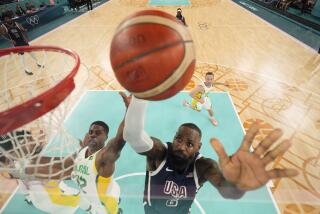Team at Deaf Games May Miss Signs, but Its Ability Is Unmistakable
- Share via
Right arm raised with four fingers extended, Dick Berg finally caught Jimmy Newsome’s attention.
Newsome, from Reseda, reacted immediately. He motioned to his teammates, and the U.S. basketball team switched into its No. 4 defense, a 1-3-1 zone trap.
The hand signal was intended, however, to inform Newsome that he had just picked up his fourth foul.
“If the players could hear, I could have stamped my feet on the floor or something and changed all that very easily,” said Berg, co-coach of the American team. “But things like that will happen.”
Things like that do happen at the World Games for the Deaf, running through July 20 at various sites in Los Angeles.
The minor communication problem was not the first for Berg, who has a deaf player, Willie Brown, on his basketball team at Hofstra University in New York. Brown is also a member of the United States team that routed Venezuela, 154-54, in its opening game Thurdsay at Pepperdine.
Nor does the unique manner of coach-player banter--where hand signals and waving towels replace the spoken word--make the game any different for Berg.
It’s still basketball, a game more visual than verbal. It’s a game in which physical ability distinguishes talent.
You can see it in Mike Torres, a former swingman at Pierce College who led all scorers Thursday night with 20 points.
Torres, 24, is one of three players on the U.S. team with Division I college ability, according to Berg. Making nine of 11 field goals and displaying a strong inside game, the 6-5 forward looked as if he could play at any level.
“He is a very good player,” Berg said. “But in Division I, he could get hurt. Like all deaf players, teams could set picks on him and that could hurt him. That’s something that has to be worked on.”
Being deaf hasn’t hampered Torres’ play so far. At Pierce, he averaged 13.6 points and eight rebounds a game. This is Torres’ second appearance in the Deaf Games.
“He’s a very good inside player,” Berg said, adding that Torres is probably the best player on the U.S. team.
The other player Berg thinks could play Division I ball--other than Brown, who already does--is David Hamilton, a former Pierce player.
Hamilton, who had 18 points against Venezuela, could get that chance next year. Through his girlfriend and interpreter Nicki Valenziano, Hamilton said Friday that he had narrowed his choice of colleges to Fresno State, Cal State Northridge and Seattle University.
His only opportunity to gain a scholarship would be at Fresno State, which has sent a scout to the Games. Hamilton said he would prefer to play in Fresno because two former teammates at Pierce--Brian Simone and Kenny Cook--play there.
He expects no communication problems at any of the three schools, he said, because interpreters will be provided. But he added that interpreters would be unnecessary if the respective coaches would learn sign language.
“It’s not hard at all to play with deaf players, but with hearing teams that pressure, I don’t have time to watch how the other teams are guarding me,” Hamilton said. To guard against blind picks on defense, he added, “I have to use my eyes a lot.”
Hamilton was joined in the backcourt Thursday by Newsome, who had 17 points against Venezuela. He returned as a top scorer for the United States after leading the team in scoring at the 1981 Games.
Through no special effort of his own, Newsome illustrated the unique communication problems that can arise between a deaf player and a coach accustomed to verbalizing commands.
But after a 100-point win, Newsome required no interpreter. A winner’s smile is unmistakable.
More to Read
Go beyond the scoreboard
Get the latest on L.A.'s teams in the daily Sports Report newsletter.
You may occasionally receive promotional content from the Los Angeles Times.






